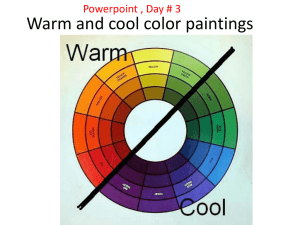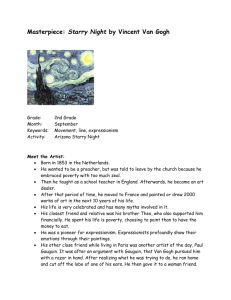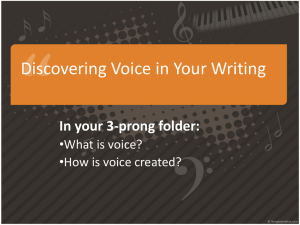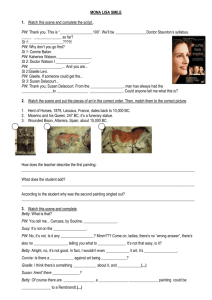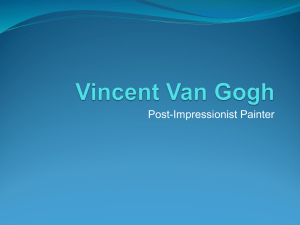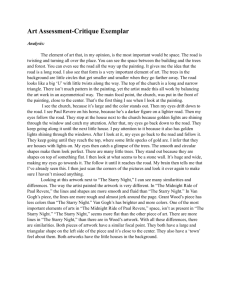Tech Talk
advertisement
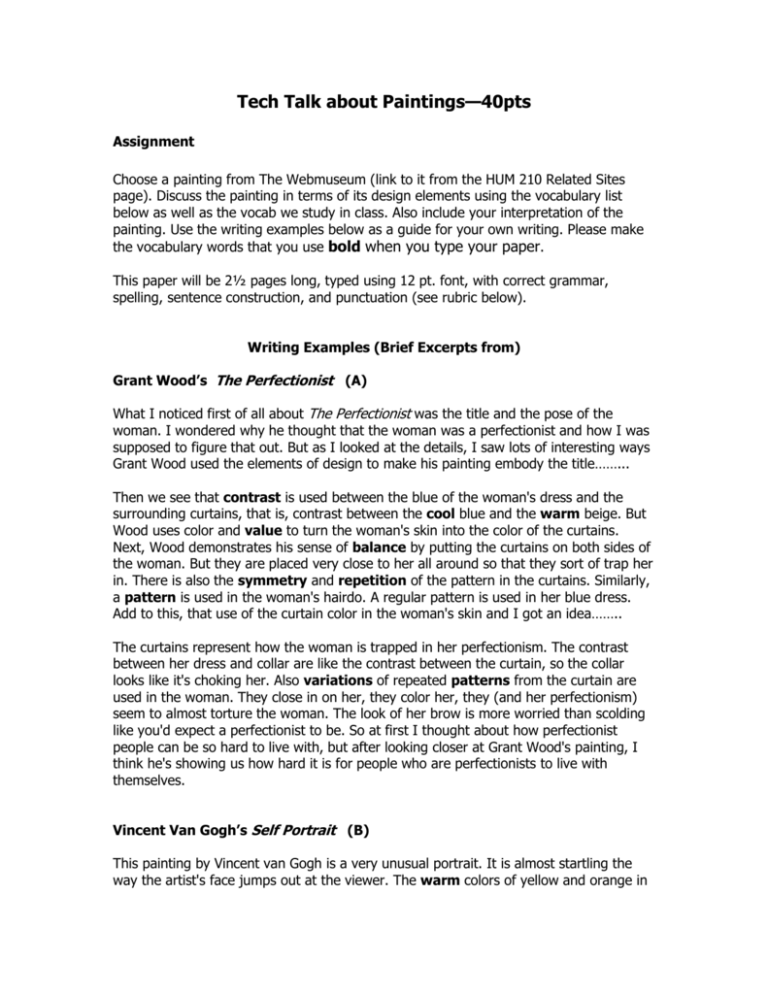
Tech Talk about Paintings—40pts Assignment Choose a painting from The Webmuseum (link to it from the HUM 210 Related Sites page). Discuss the painting in terms of its design elements using the vocabulary list below as well as the vocab we study in class. Also include your interpretation of the painting. Use the writing examples below as a guide for your own writing. Please make the vocabulary words that you use bold when you type your paper. This paper will be 2½ pages long, typed using 12 pt. font, with correct grammar, spelling, sentence construction, and punctuation (see rubric below). Writing Examples (Brief Excerpts from) Grant Wood’s The Perfectionist (A) What I noticed first of all about The Perfectionist was the title and the pose of the woman. I wondered why he thought that the woman was a perfectionist and how I was supposed to figure that out. But as I looked at the details, I saw lots of interesting ways Grant Wood used the elements of design to make his painting embody the title……... Then we see that contrast is used between the blue of the woman's dress and the surrounding curtains, that is, contrast between the cool blue and the warm beige. But Wood uses color and value to turn the woman's skin into the color of the curtains. Next, Wood demonstrates his sense of balance by putting the curtains on both sides of the woman. But they are placed very close to her all around so that they sort of trap her in. There is also the symmetry and repetition of the pattern in the curtains. Similarly, a pattern is used in the woman's hairdo. A regular pattern is used in her blue dress. Add to this, that use of the curtain color in the woman's skin and I got an idea…….. The curtains represent how the woman is trapped in her perfectionism. The contrast between her dress and collar are like the contrast between the curtain, so the collar looks like it's choking her. Also variations of repeated patterns from the curtain are used in the woman. They close in on her, they color her, they (and her perfectionism) seem to almost torture the woman. The look of her brow is more worried than scolding like you'd expect a perfectionist to be. So at first I thought about how perfectionist people can be so hard to live with, but after looking closer at Grant Wood's painting, I think he's showing us how hard it is for people who are perfectionists to live with themselves. Vincent Van Gogh’s Self Portrait (B) This painting by Vincent van Gogh is a very unusual portrait. It is almost startling the way the artist's face jumps out at the viewer. The warm colors of yellow and orange in the face contrast sharply with the cool background and jacket. One can’t help but look more closely at the face, with those warm colors. However, even though the yellow face with highlights of light green catches the viewer’s attention, the most arresting feature are the eyes. The color in his eyes links with the cool background color, which swirls in a rhythmic pattern very close to the head. They look directly out of the painting at the viewer, but from a sideways glance. This, along with the green highlights on the face, gives a threatening or cramped feeling. It is clear that that van Gogh used variations and contrasts in color, texture, and rhythm to make a complex statement about how satisfying, but scary, it might be for an artist to rebel against what's considered normal…. The knit of the heavy brow adds to a look that suggests strength or rebellion. This unusual choice of facial colors supports the idea that van Gogh is making a rebellious statement. But rebellion about what?…. As one moves the eye from the face, it will flow down the white path of the shirt to the artist's palette. The tactile textured dabs of paint on the palette seem like the most realistic parts of the painting. Perhaps it is in the world of art that van Gogh sees himself as a rebel. But instead of showing off about this, van Gogh seems nervous about it.... Tech Talk Rubric Ratings A 9-10 B 8 C 7 Number of Elements Discussion 6 or more correctly identified 5 elements correctly identified 3-4 elements correctly identified 1-2 elements correctly identified Shows complete understanding of terms and techniques Shows some understanding of terms and techniques Shows little or no understanding of terms and techniques Interpretation Interprets the elements as it goes, to build a supported analysis Shows a good but not complete understanding of terms and techniques Offers at least a final interpretation which is tied to some or all of the elements Offers a final interpretation but is not tied to elements No interpretation Written Expression A well-crafted paper that persuasively argues its case. No writing errors A solid paper that shows care in writing. Minor writing errors Brief, but clearly written. Many errors but they do not hinder reader Sentence problems, misspelled words, punctuation errors, etc. which make paper hard to read 36-40 = A 32-35 = B 28-31 = C 24-27 = D 23 = F D 6 Vocabulary List (Partial) This is for your use to take notes as we explore the terms more fully in class lectures Color (note—you cannot simply use the word color; you must describe it, such as warm, cold, shade, tint, etc.) Visual sensation dependent on the reflection or absorption of light from a given surface. Terms used to talk about color can include warm, cool, value, intensity, shade, tint, as well as others. Line An identifiable path of a point moving in space. It can vary in width, direction, and length. Value Light and dark; the gradations of light and dark on the surface of objects. Shape A two-dimensional area or plane that may be organic or geometric. Symmetry A balance in which elements are alike and will appear to demand one another, like a seesaw. Asymmetry A balance achieved through the use of unequal parts or elements. Texture The surface quality of material, either actual (tactile) or visual. Contrast Use of opposites in close proximity (light and dark, rough and smooth, organic and geometric, etc.). Rhythm The regular repetition of particular forms or stresses such as line or shape/form Theme and Variation Some dominant design feature repeated with variations to give the work its dominant Character such as shapes or lines. Others—(notes from in class lectures)


